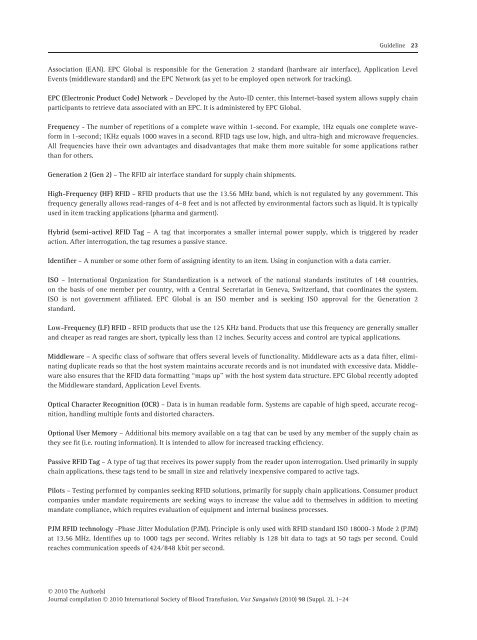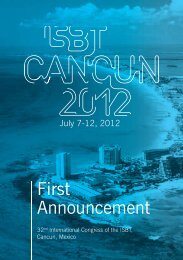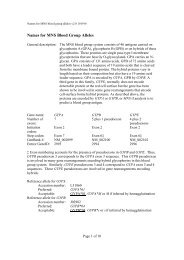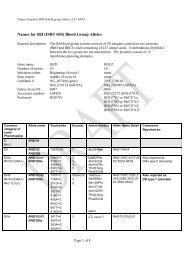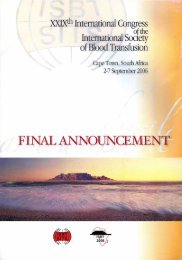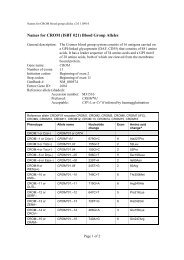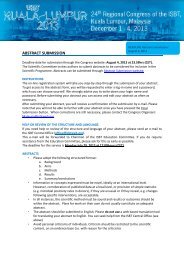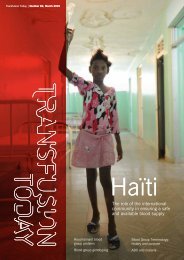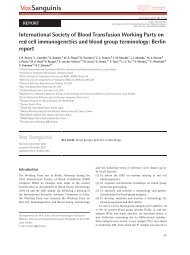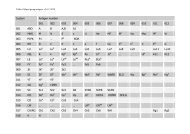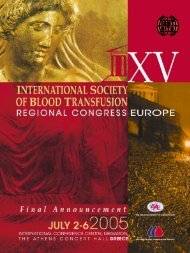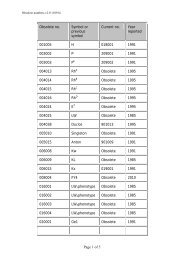Guidelines for the Use of RFID Technology in Transfusion Medicine
Guidelines for the Use of RFID Technology in Transfusion Medicine
Guidelines for the Use of RFID Technology in Transfusion Medicine
Create successful ePaper yourself
Turn your PDF publications into a flip-book with our unique Google optimized e-Paper software.
Guidel<strong>in</strong>e 23Association (EAN). EPC Global is responsible <strong>for</strong> <strong>the</strong> Generation 2 standard (hardware air <strong>in</strong>terface), Application LevelEvents (middleware standard) and <strong>the</strong> EPC Network (as yet to be employed open network <strong>for</strong> track<strong>in</strong>g).EPC (Electronic Product Code) Network – Developed by <strong>the</strong> Auto-ID center, this Internet-based system allows supply cha<strong>in</strong>participants to retrieve data associated with an EPC. It is adm<strong>in</strong>istered by EPC Global.Frequency - The number <strong>of</strong> repetitions <strong>of</strong> a complete wave with<strong>in</strong> 1-second. For example, 1Hz equals one complete wave<strong>for</strong>m<strong>in</strong> 1-second; 1KHz equals 1000 waves <strong>in</strong> a second. <strong>RFID</strong> tags use low, high, and ultra-high and microwave frequencies.All frequencies have <strong>the</strong>ir own advantages and disadvantages that make <strong>the</strong>m more suitable <strong>for</strong> some applications ra<strong>the</strong>rthan <strong>for</strong> o<strong>the</strong>rs.Generation 2 (Gen 2) – The <strong>RFID</strong> air <strong>in</strong>terface standard <strong>for</strong> supply cha<strong>in</strong> shipments.High-Frequency (HF) <strong>RFID</strong> – <strong>RFID</strong> products that use <strong>the</strong> 13.56 MHz band, which is not regulated by any government. Thisfrequency generally allows read-ranges <strong>of</strong> 4–8 feet and is not affected by environmental factors such as liquid. It is typicallyused <strong>in</strong> item track<strong>in</strong>g applications (pharma and garment).Hybrid (semi-active) <strong>RFID</strong> Tag – A tag that <strong>in</strong>corporates a smaller <strong>in</strong>ternal power supply, which is triggered by readeraction. After <strong>in</strong>terrogation, <strong>the</strong> tag resumes a passive stance.Identifier – A number or some o<strong>the</strong>r <strong>for</strong>m <strong>of</strong> assign<strong>in</strong>g identity to an item. Us<strong>in</strong>g <strong>in</strong> conjunction with a data carrier.ISO – International Organization <strong>for</strong> Standardization is a network <strong>of</strong> <strong>the</strong> national standards <strong>in</strong>stitutes <strong>of</strong> 148 countries,on <strong>the</strong> basis <strong>of</strong> one member per country, with a Central Secretariat <strong>in</strong> Geneva, Switzerland, that coord<strong>in</strong>ates <strong>the</strong> system.ISO is not government affiliated. EPC Global is an ISO member and is seek<strong>in</strong>g ISO approval <strong>for</strong> <strong>the</strong> Generation 2standard.Low-Frequency (LF) <strong>RFID</strong> - <strong>RFID</strong> products that use <strong>the</strong> 125 KHz band. Products that use this frequency are generally smallerand cheaper as read ranges are short, typically less than 12 <strong>in</strong>ches. Security access and control are typical applications.Middleware – A specific class <strong>of</strong> s<strong>of</strong>tware that <strong>of</strong>fers several levels <strong>of</strong> functionality. Middleware acts as a data filter, elim<strong>in</strong>at<strong>in</strong>gduplicate reads so that <strong>the</strong> host system ma<strong>in</strong>ta<strong>in</strong>s accurate records and is not <strong>in</strong>undated with excessive data. Middlewarealso ensures that <strong>the</strong> <strong>RFID</strong> data <strong>for</strong>matt<strong>in</strong>g ‘‘maps up’’ with <strong>the</strong> host system data structure. EPC Global recently adopted<strong>the</strong> Middleware standard, Application Level Events.Optical Character Recognition (OCR) – Data is <strong>in</strong> human readable <strong>for</strong>m. Systems are capable <strong>of</strong> high speed, accurate recognition,handl<strong>in</strong>g multiple fonts and distorted characters.Optional <strong>Use</strong>r Memory – Additional bits memory available on a tag that can be used by any member <strong>of</strong> <strong>the</strong> supply cha<strong>in</strong> as<strong>the</strong>y see fit (i.e. rout<strong>in</strong>g <strong>in</strong><strong>for</strong>mation). It is <strong>in</strong>tended to allow <strong>for</strong> <strong>in</strong>creased track<strong>in</strong>g efficiency.Passive <strong>RFID</strong> Tag – A type <strong>of</strong> tag that receives its power supply from <strong>the</strong> reader upon <strong>in</strong>terrogation. <strong>Use</strong>d primarily <strong>in</strong> supplycha<strong>in</strong> applications, <strong>the</strong>se tags tend to be small <strong>in</strong> size and relatively <strong>in</strong>expensive compared to active tags.Pilots – Test<strong>in</strong>g per<strong>for</strong>med by companies seek<strong>in</strong>g <strong>RFID</strong> solutions, primarily <strong>for</strong> supply cha<strong>in</strong> applications. Consumer productcompanies under mandate requirements are seek<strong>in</strong>g ways to <strong>in</strong>crease <strong>the</strong> value add to <strong>the</strong>mselves <strong>in</strong> addition to meet<strong>in</strong>gmandate compliance, which requires evaluation <strong>of</strong> equipment and <strong>in</strong>ternal bus<strong>in</strong>ess processes.PJM <strong>RFID</strong> technology -Phase Jitter Modulation (PJM). Pr<strong>in</strong>ciple is only used with <strong>RFID</strong> standard ISO 18000-3 Mode 2 (PJM)at 13.56 MHz. Identifies up to 1000 tags per second. Writes reliably is 128 bit data to tags at 50 tags per second. Couldreaches communication speeds <strong>of</strong> 424 ⁄ 848 kbit per second.Ó 2010 The Author(s)Journal compilation Ó 2010 International Society <strong>of</strong> Blood <strong>Transfusion</strong>, Vox Sangu<strong>in</strong>is (2010) 98 (Suppl. 2), 1–24


